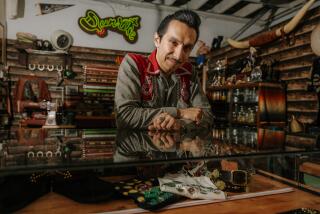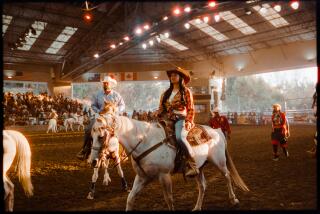Review: ‘Striking Iron: The Art of African Blacksmiths’ shows the delicate artistry of clever metalworkers
- Share via
From pumping iron at the gym to the superhero adventures of Iron Man, the symbolic use of iron in American culture today is pretty much limited to a single theme. Brute strength, perhaps reflecting our unceasing militaristic swagger, is brusquely signified.
In Africa, by contrast, iron — the most common element on Earth – has for centuries been a more nuanced emblem. At the Fowler Museum at UCLA, the engrossing exhibition “Striking Iron: The Art of African Blacksmiths” shows how.
Power is certainly at issue in the abundance of weaponry forged from the material, both functionally and metaphorically. Watch out for this specific weapon, the weighty, elemental material says. Whether straightforward spears and daggers or elaborately decorated shields, axes and throwing knives, iron armaments possess physical strength.
Yet, a very different kind of muscle is represented when a gifted craftsman has the talent and expertise to forge iron into something that is dazzling to look at. Watch out for the sharp and clever people who made it, a deft design declares. They are powerful too.
Strength and intensity can assume subtle interpretations. Take a small apron, called a cache-sexe.
Worn to cover a woman’s pubic region, one example is composed of a fringe of gently curved iron pods suspended from a leather belt. Crude iron, dug from the earth, has been elegantly transformed through the difficult, time-consuming process of smelting and forging. A cache-sexe links that process to another transformative power – a woman’s human metamorphosis in fertility. Creation is signified and embodied.
“Striking Iron” is a large and absorbing exhibition, apparently the first of its kind to survey the importance of the material and the sophistication in its uses on the continent, mostly in regions south of the Sahara Desert. Objects both utilitarian and ceremonial are included – more than 225 in all – mostly from the 19th and early 20th centuries.
A few date from earlier periods. Iron has been an essential material in Africa for more than 2,500 years, with a wide variety of artistic manifestations. The elegantly curved, oversize fingers on a small, 17th or 18th century wrought-iron figure from the Kuba/Bushoong peoples of today’s Democratic Republic of the Congo slyly celebrate the primacy of the human hand. The grinning, gnome-like little figure, whose purpose is not known for sure, seems to pantomime welcoming gestures.
The organizing team for “Striking Iron” was led by Tom Joyce, a master blacksmith based in Santa Fe, N.M., who was named a MacArthur Fellow in 2003. (Several short, explanatory videos featuring Joyce are on view.) Marla C. Berns, director of the Fowler Museum, worked with three other scholars of African art and culture at American universities, who contributed deep expertise.
A catalog is unfortunately not yet available. The Fowler expects to publish one before the show travels to Washington’s National Museum of African Art in February and to the Musée du quai Branly-Jacques Chirac in Paris in November 2019.
Individual objects are accompanied by helpful labels. The exhibition is also well laid-out, conceived as a sequence of eight chapters that consider iron for both its material and metaphorical properties.
One technical section explains the smelting and forging process, in which the artisan’s equipment is itself often ornamented. (The bellows used for pumping air into a fire is likened to human lungs, which explains why carved heads adorn two sets of bellows.) Archaeology traces the historical origins of the forging process, as well as some of the stories told about iron’s place in the cosmologies of multiple African societies. Spiritual implements, tools (especially for agriculture), armaments and percussion instruments each get separate sections.
Among the most fascinating is “Blades of Value.” Currency tokens – a type of monetary exchange voucher that, unlike coins, are not issued by a government or central authority – are forged in sometimes elaborate iron shapes.
One hefty bundle of about a dozen large, knife-like blades, each nearly two feet long, is bound together with cord at the tips. The composition looks like a ceremonial bouquet of lethal weaponry. Used by the Budja peoples in the late 19th century as payment made by a groom to ratify a marriage, the unnerving bunch of stiletto forms suggests that the spousal transaction should not be taken lightly.
Or else.
Another 19th century currency token, this one from the Ndengese people of Central Africa, is uncommonly elegant. Nearly 3 feet tall, it features a hefty central iron post spouting three big, thin blades whose curvilinear flourishes might best be described as calligraphic.
Looking like a fluid stroke of ink on paper rendered from a brush more than white-hot iron hammered on a resistant anvil, the silhouettes taper at the ends to impossibly delicate finials. These flared shapes derive from throwing knives used in combat or hunting – another example of the object’s social gravity.
“Blades of Value” also harbors the seeds of ruin. Beginning in the 15th century, European incursions steadily upended local African economies.
Iron is hardly unique to Africa, and the mass import from abroad of foreign replicas of currency tokens undermined homegrown values. Colonial powers even went so far as to forbid indigenous production, forcing numerous sub-Saharan societies to acquire European iron. Primal artistic traditions were crudely interrupted.
The exhibition roams far and wide in the kinds of metal objects being surveyed.
Scarified markings decorating one staff and a fluttering flock of birds that rises from another signify the holders as herbalists. Portable, umbrella-shaped altars showcase sculptural genre scenes of daily life. (Likewise, a wood mask is crowned by carved blacksmiths at work around a forge.) A fierce, anthropomorphic power figure – one of the famous minkisi n’kondi from the region now known as the Democratic Republic of the Congo – is ritualistically bound with strips of multicolored cloth and hammered with hundreds of nails and ceremonial iron shards.
The array gets steadily more elaborate as you move through the show. By the end, you’re unlikely ever again to regard iron as just a mute, brute material. In that, “Striking Iron” strikes gold.
Fowler Museum at UCLA, 308 Charles E. Young Dr. North, (310) 825-4361, through Dec. 30. Closed Mon. and Tue. www.fowler.ucla.edu
Twitter: @KnightLAT
More to Read
The biggest entertainment stories
Get our big stories about Hollywood, film, television, music, arts, culture and more right in your inbox as soon as they publish.
You may occasionally receive promotional content from the Los Angeles Times.











